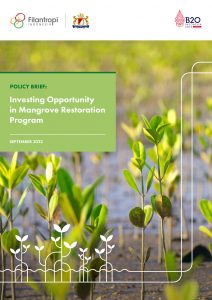Summary and Key Messages
Mangroves provide a vital link between terrestrial and oceanic carbon cycles and are one of the most carbon-dense vegetated ecosystems globally, due in part to their high rates of carbon sequestration compared to other ecosystems. The value of mangroves restoration extends far beyond climate change mitigation, they support communities and biodiversity resilience by regulating nutrients, sustaining fisheries, and protecting coasts from storms.
Conservation and restoration of mangroves provide an important opportunity for climate change countermeasure. Restoring 1.6 million hectares of disturbed and degraded mangrove in Indonesia to a healthy state would reduce emission up to 59.4 million tons of CO2 emissions over the next 10 years, and open the door to new economic opportunities such as carbon economy, eco-tourism, and sustainable fisheries.
The advantages of the private sector and financial institutions investment to scaling up mangrove restoration are their leverage to push for faster change through engagement and capital allocation. This trend is expected to strengthen as the new generations of investors, increasingly aware of the environment, social, and governance (ESG) issues, seek investments aligned with their values. Equally, the project itself would profit from the same rigorous approach to project diligence, selection, and feasibility assessment, as done in standard portfolio management.
The government and financial services regulator need to create a supportive enabling environment with efficient and effective incentives, standards and regulations, improved data management, and concessional finance. For the interest of the private sector, nature risks stemming from both impact and dependency on healthy mangroves can be incorporated into investment decisions through risk measurement and reporting. This will encourage financial services to operate with consideration of their financing decision impacts on businesses sustainability and ecosystem integrity (greening finance). In addition, more innovation in finance in developing projects with sufficient cash flow and returns, as well as financial instruments with an attractive risk-return profile, is needed (financing green).
